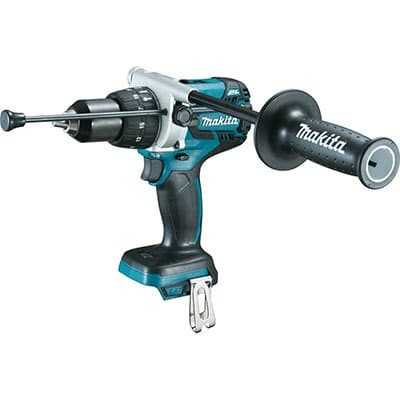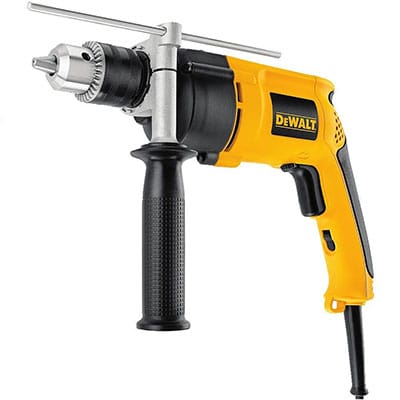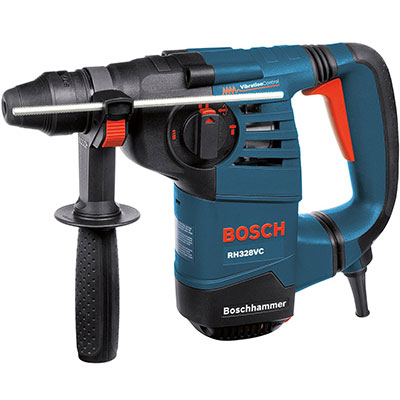Best Hammer Drills — Buyer’s Guide, Top Picks, and Comparison
Hammer Drill Categories
Hammer Drill Information
Drill Hammer Categories

Cordless Hammer Drill
Not being constrained by a power cable — these units allow you to operate away from your site or in areas that require high-level access. Driven by long-lasting lithium-ion cells, they don’t push out quite as much heft as mains-powered models, yet still perform admirably with concrete and brickwork. It’s advisable to have a secondary power cell, however, to prevent the need for recharging mid-project.

Corded Hammer Drill
Offering powerful pounding, the best electric hammer drill units effortlessly bore into dense masonry, concrete, and brickwork. With high impact rates — typically in excess of 46000 bpm — these grunty tools cope with mediums too tough for a standard machine. Often boasting anti-vibration tech, they cut back on user fatigue and deliver consistent, unwavering power. And, with the ability to turn off the hammer feature, they can be utilized as a traditional rotary drill — making them versatile all-around DIY tools.

Rotary Hammer Drill
For the absolute maximum in heft — you need a rotary drill. While they still pound away like the standard hammer models, they incorporate a piston mechanism instead of a clutch — providing much more power. Additionally, they also feature a hammer-only setting, enabling you to use the unit for demolition much like a jackhammer.
Our Hammer Drill Top Picks In Each Category
| IMAGE | PRODUCT | DETAILS | ||
|---|---|---|---|---|
|
Best Cordless 
|
Best Cordless
|
Makita XPH07Z
|
Features
|
Check Price at Amazon Makita XPH07Z Review Makita XPH07Z Review |
|
Best Corded 
|
Best Corded
|
DeWalt DW511
|
Features
|
Check Price at Amazon DeWalt DW511 Review DeWalt DW511 Review |
|
Best Rotary 
|
Best Rotary
|
Bosch RH328VC
|
Features
|
Check Price at Amazon Bosch RH328VC Review Bosch RH328VC Review |
Finding the Best Hammer Drills – Buyer’s Guide
With a repetitive forward and backward pounding motion — in addition to their rotary movement — they break down dense materials, allowing you to bore into mediums too substantial for a standard machine.
Ranging from the traditional corded and cordless hammer machines through to seriously hardcore rotary units — there’s a tool for every user and stubborn masonry application.
Types of Power Hammer Drill Machines
Corded Hand Held Hammer Drill
What most people would recognize as a ‘traditional’ hammer drill machine. Utilizing an internal geared clutch mechanism, these units deliver a punching motion in addition to their rotational movement — making light work of dense masonry.
Being corded, they typically offer greater speed, torque, and impact rates (measured in blows per minute, or bpm) than their cordless counterparts — generally speaking, they knock out around 3000 rpm and over 45000 bpm.
Furthermore, their mains-driven feature permits them to deliver unremitting and stable power — unlike their battery-powered siblings that gradually lose grunt and reliability as their cells drain.
One of the key features of these machines, shared with the cordless models, is that the hammer feature can be turned off — allowing you to use the units as a pure rotational boring tool. It’s for this reason that a good hammer drill can be the consummate DIY machine — allowing you to address masonry with the pounding setting, and timbers and plastics with the rotation.
Pros of Corded Hammer Drill
- Affordable — a versatile cheap hammer drill.
- Consistent power output.
- No requirement to purchase power cells.
- Hammer action can be disengaged.
- Straightforward operation.
Cons of Corded Hammer Drill
- Not the best rated hammer drill for demolition work.
- Need access to mains power.
- Short leads — will usually require an extension.
Cordless Compact Hammer Drill
Offering similar functionality to their corded counterparts — battery-powered hammer drills are the overlords of operational freedom. Driven by long-lasting lithium-ion cells, these machines allow you to pound away at concrete and brickwork away from a mains source — increasing their site versatility.
Due to the restriction of power availability, you can expect the speed and impact output to be slightly lower than corded models — with cordless tools offering around 2000 rpm and 40000 bpm.
That said, they still offer both a rotational and hammer function, the latter being disengageable for pure boring action. Hence, if you’re seeking a battery-powered DIY all-rounder, I’d recommend considering one of these machines.
One of their major downsides is that they don’t usually work out as the best value hammer drill tools on the market. Not just harder on the pocket than the corded models, they often lack an included battery and charger — making additional purchases necessary.
However, neither the mains-powered nor battery-driven machines are the most powerful drills in the hammer drill arena. If you want the ultimate in grunt, you need to check out the next category — the rotary tools.
Pros of Cordless Hammer Drill
- No mains cord tethering.
- More suited to high-level work than corded units.
- Similar function to electrical lead models.
- Can be an excellent DIY all-rounder.
- Variable speed functions.
Cons of Cordless Hammer Drill
- Harder on the wallet than mains machines — high hammer drill prices.
- Often don’t include cells or chargers.
- Lowest power output of all the hammer drill categories.
Rotary Hammer Drill
Undoubtedly, the most powerful hammer drill machines in the entire pounding category.
Featuring a piston mechanism, instead of the clutch in standard corded and cordless hammer drills, the rotary units feature an internal air pocket that drives the piston and cushions the motor components — giving rise to their alternative name, electro-pneumatic drills.
This allows these mothers of destruction to deliver more punching output than the traditional machines — although with lower rpm and bpm. Their secret is the force that each blow delivers, measured in foot-pounds.
Standard bits are abandoned in favor of the more resilient SDS+ chuck system. Furthermore, they boast twin handles — required to tame these beasts — and anti-vibration systems to shield you from the high oscillations created by these grunty Goliaths.
Hardcore project-specific — you cannot turn off the hammer feature. This makes them unsuitable for timber, metal, and plastic work — in fact, any project that doesn’t require crunching concrete.
That said, you can turn off the rotational motion — making the drill into a pure pounding tool. This enables you to utilize the rotary drill as a demolition unit, an application impossible with standard hammer drills.
Pros of Rotary Hammer Drill
- Most powerful machines in the hammer category.
- Suitable for contractor-grade applications.
- Can be used as demolishing machines.
- Available in rotary corded and cordless rotary formats.
- Utilize robust SDS+ drill bits.
Cons of Rotary Hammer Drill
- Cannot be used on timber, plastic, or wood.
- Project-specific — not an ideal DIY machine.
- Require some strength to use.
- Least affordable of all hammer drills.
- Low speeds.
Uses for a Hammer Drill Kit
- Boring into dense construction materials.
- Creating anchor points in building footings.
- Channeling concrete and brickwork.
- Mounting stanchions.
- Installing UPVC windows.
- Hanging HVAC units.
- Attaching rainwater goods to home exteriors.
- Addressing timber and plastic with the hammer disengaged.*
- Removing broken concrete to prep for repair.⤉
- Chiseling render.⤉
- Demolition.⤉
*Standard corded and cordless hammer drills only.
⤉Rotary hammer drills only.
Precautions and Safety for Hammer Drilling Machines
As a responsible DIYer or trade pro, you naturally take sensible safety precautions on all of your drilling projects.
However, when using a hammer machine on masonry — whether you’re using a corded, cordless, or rotary model — there are specific hazard considerations to take into account before commencing your work.
Cement, bonded hardcore, brickwork, castings, and concrete all contain crystalline silica. When you drill, bore, and chip these materials — they emit airborne silica elements. And, if you inhale these microscopic particles, they can be a danger to your health.
Research explains that utilizing a power tool to drill into these mediums elevates airborne silica to over 280 times the National Institute for Occupational Safety and Health (NIOSH) safe exposure limits.
Inhaling airborne silica can lead to:
Hence, when using a hammer drill on masonry, it’s crucial that you safeguard yourself from risk by:
- Donning an industry-grade respiratory mask.
- Ensuring your drilling area is sufficiently ventilated.
- Boosting airflow with an electric fan.
- Taking periodic breaks.
- Drilling outside if possible.
- Damping down floor-settled dust with water.
Considerations When Purchasing a Hammer Drill
The corded, cordless, and rotary hammer drills have particular characteristics that you need to consider when selecting your optimum power tool.
For a detailed examination of these individual formats, I suggest you check out my in-depth guides to rotary, corded, and cordless machines. However, when you compare hammer drills before purchase, I recommend that you look into these factors:
Format
Undoubtedly, the primary consideration when making hammer drill comparisons — should you opt for corded, cordless, or rotary?
Generally speaking, if you’re seeking a flexible tool that can handle timber, wood, and stubborn masonry — opt for a standard corded or cordless hammer drill. Allowing you to switch from hammer with rotation to rotation only — they’re the consummate all-rounder. And naturally, it’s up to you whether you’d prefer the operational freedom of a battery-driven machine or the consistent unwavering power of a crowded unit.
However, if you demand the gruntiest tool on the market, are not planning on using the tool on wood or metal, and wish to demolish and chip in addition to drilling into masonry — go for a rotary tool.
Impact Rate
Described in bpm (blows-per-minute), the impact rate explains how often the bit pounds your target medium. Theoretically, the higher the number of punches, the faster you’ll drive through masonry.
However, there’s an exception.
Rotary hammer drills, due to their immense brawn, don’t require such a high blow rate — typically delivering the same efficient crushing action at 10 percent of the rapidity of a standard corded or cordless tool.
This is crucial when choosing your optimum masonry drill, as you need to ensure you’re comparing like-with-like. Hence, a rotary machine knocking out 4400 bpm should provide the same brick-crushing enjoyment as a corded unit delivering 44000 bpm.
Anti-Vibration System
Often referred to in hammer drill literature as simply AVS — an anti-vibration system is crucial for hardcore masonry drilling.
Wielding a grunty tool while plowing into the densest of mediums can place significant stress on your hands, wrist, and arms — while also punishing the internal components of your hammer drill.
A true AVS will include a combination of grips, paddings, shock-absorbers, and springs to shield the machine from damage and protect you from short and long-term pain or injury — while elevating stamina on lengthy projects.
Furthermore, while this feature is a welcome benefit on standard corded and cordless hammer machines — it’s essential on the behemoth rotary tools that knock out a scary level of power.
Chuck Size and Type
The chuck size is only a factor for corded and cordless hammer drills. Generally speaking, they come in two dimensions: 0.375-inch and 0.5-inch.
The 0.375 inch is a solid, DIY size — able to accommodate the most widely used diameter bits for metal, timber, and masonry. The 0.5-inch chuck permits you to utilize more substantial boring heads — useful if your projects include channeling for narrow pipework or wiring.
Again, rotary hammers are the exception. These tools boast SDS+ compatible chucks — a system that allows the bit to slide forward and backward along the horizontal plane — crucial to prevent damage to the piston and bit that are under considerable force with every blow.
Motor Type
Brushed or brushless — that is the question.
A hammer drill brushless motor creates less friction and heat than their brushed counterparts. This leads to higher power input/power output efficiency, and shields against motor burnout due to excessively elevated temperatures.
This is an important consideration when you’re looking at cordless hammer drills or cordless rotary machines. A brushless motor, due to its greater efficiency, will incur less drain on the power cell — leading to longer operational times from a single charge.
Conclusion
If your projects include addressing brickwork, blockwork, cement, and concrete — you need a hammer drill.
Combining pounding action with rotational motion, these machines allow you to drill into these dense construction mediums without mangling your machine or blunting your bit.
Above all, consider the format. For an all-rounder that can tackle brickwork and timber — go for a freedom-boosting cordless model or power-reliable corded unit. To tackle the densest of cement and to chip and demolish, opt for a rotary machine.
Admittedly, these units aren’t for everyone. If your work involves mainly wood, metal, or plastic materials — or you wish to drive screws and bolts — instead, set your sights on a drill driver.
But, if you’re a DIYer or trade pro that needs a unit to cope with the demands of stubborn masonry — there’s no other choice than hammer drills.
Types of Hammer Drills FAQs
Q: How Much Is a Hammer Drill?
The hammer drill price can range from a budget $30 for a corded unit, through to premium-priced rotary machines over $1000.
Q: Can You Buy a Rotary Hammer Drill Driver?
No. You cannot turn off the pounding action on a rotary hammer machine — meaning that if you try to address a screw, all you will do is obliterate it. Instead, go for a drill/driver.
Q: How Much Does a Hammer Drill Cost
The hammer drill cost depends on whether it’s corded, cordless, or a rotary machine. You can typically purchase a good quality corded small hammer drill for around $70, an impressive cordless model for just over $100, and a powerful rotary unit for around $200.
Q: What Is the Top Hammer Drill?
In my opinion, and reflected in many online hammer drill reviews, the ultimate hammer drill is the Bosch RH328VC. This machine offers 2.4 ft-pounds of hammering force, anti-vibration control, and a three-finger throttle.
Q: Why Is It Called a Hammer Drill?
It refers to the pounding action of the drill bit, which not only rotates — as with a standard drill — but also ‘hammers’ backward and forwards on the vertical plane. This allows the machines to break up hard masonry materials that would otherwise be too dense for straightforward rotational drilling.
